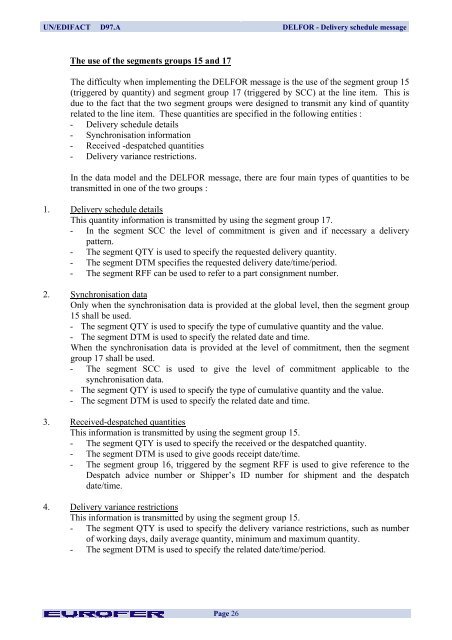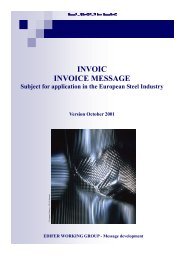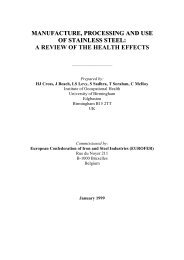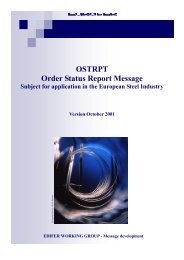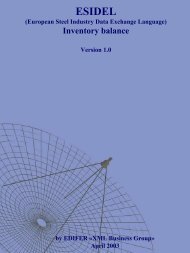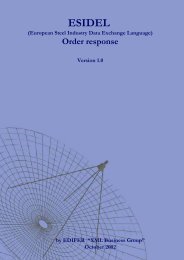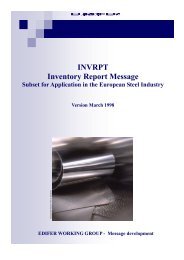DELFOR Delivery Schedule Message - Eurofer
DELFOR Delivery Schedule Message - Eurofer
DELFOR Delivery Schedule Message - Eurofer
You also want an ePaper? Increase the reach of your titles
YUMPU automatically turns print PDFs into web optimized ePapers that Google loves.
UN/EDIFACT D97.A <strong>DELFOR</strong> - <strong>Delivery</strong> schedule message<br />
The use of the segments groups 15 and 17<br />
The difficulty when implementing the <strong>DELFOR</strong> message is the use of the segment group 15<br />
(triggered by quantity) and segment group 17 (triggered by SCC) at the line item. This is<br />
due to the fact that the two segment groups were designed to transmit any kind of quantity<br />
related to the line item. These quantities are specified in the following entities :<br />
- <strong>Delivery</strong> schedule details<br />
- Synchronisation information<br />
- Received -despatched quantities<br />
- <strong>Delivery</strong> variance restrictions.<br />
In the data model and the <strong>DELFOR</strong> message, there are four main types of quantities to be<br />
transmitted in one of the two groups :<br />
1. <strong>Delivery</strong> schedule details<br />
This quantity information is transmitted by using the segment group 17.<br />
- In the segment SCC the level of commitment is given and if necessary a delivery<br />
pattern.<br />
- The segment QTY is used to specify the requested delivery quantity.<br />
- The segment DTM specifies the requested delivery date/time/period.<br />
- The segment RFF can be used to refer to a part consignment number.<br />
2. Synchronisation data<br />
Only when the synchronisation data is provided at the global level, then the segment group<br />
15 shall be used.<br />
- The segment QTY is used to specify the type of cumulative quantity and the value.<br />
- The segment DTM is used to specify the related date and time.<br />
When the synchronisation data is provided at the level of commitment, then the segment<br />
group 17 shall be used.<br />
- The segment SCC is used to give the level of commitment applicable to the<br />
synchronisation data.<br />
- The segment QTY is used to specify the type of cumulative quantity and the value.<br />
- The segment DTM is used to specify the related date and time.<br />
3. Received-despatched quantities<br />
This information is transmitted by using the segment group 15.<br />
- The segment QTY is used to specify the received or the despatched quantity.<br />
- The segment DTM is used to give goods receipt date/time.<br />
- The segment group 16, triggered by the segment RFF is used to give reference to the<br />
Despatch advice number or Shipper’s ID number for shipment and the despatch<br />
date/time.<br />
4. <strong>Delivery</strong> variance restrictions<br />
This information is transmitted by using the segment group 15.<br />
- The segment QTY is used to specify the delivery variance restrictions, such as number<br />
of working days, daily average quantity, minimum and maximum quantity.<br />
- The segment DTM is used to specify the related date/time/period.<br />
Page 26


